Revenue opportunities are popping up at arenas and stadiums.
While the footprint of today’s facilities keeps growing to maximize programming needs, there never seems to be enough space to accommodate fans and sponsors, which can hamper efforts to grow revenue.
Enter pop-ups, defined in the sports world as temporary seating and hospitality spaces that quickly go up and come back down depending on the event. These temporary spaces meet the needs of premium patrons as teams diversify their seating products.
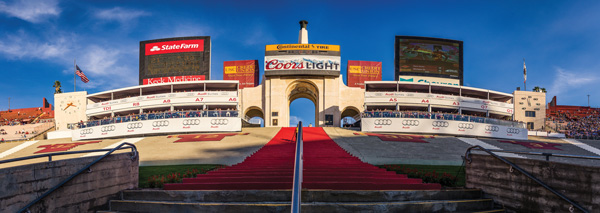 |
The Audi Suites at Los Angeles Memorial Coliseum.
Photo by: Los Angeles Memorial Coliseum |
You will find the concept in play at arenas such as Staples Center that have multiple tenants and calendars packed with events. The revolving door of activity keeps the Los Angeles arena constantly in transition, leading facility owner/operator AEG and the Los Angeles Clippers to find a temporary solution to develop new amenities for some of their highest-paying customers.
In other instances, buildings such as Barclays Center go through retrofits to accommodate a second sport. Making the adjustment for NHL games resulted in prime pop-up seats for the New York Islanders after the team relocated to Brooklyn last fall.
A vintage building such as Los Angeles Memorial Coliseum lacks the suites and clubs common at much newer stadiums, so pop-up structures fill a niche for college football fans willing to pay for a premium experience in a temporary setting.
Even for roomy racetracks, with large gaps between events and where pop-up hospitality is a standard feature on race day, venues such as Circuit of the Americas are creating even more temporary destinations to bring additional value within their sprawling properties.
On the sponsorship side, pop-ups provide automakers Audi, Honda and Lexus, and energy drink Red Bull, greater exposure through naming rights and product displays, whether they’re separate deals or add-ons as part of renewing their deals.
“I see the trend increasing,” said Terry McIntyre, Shawmut Design and Construction’s director of business development. “On their own, arenas don’t have as much real estate as stadiums, and it’s another way to drive income by creating something that you can tear down and use the space for something else at another event.”
LEXUS COURTSIDE CLUB
Staples Center
Prior to the 2015-16 season, the Clippers created a premium club in a backstage space at Staples Center where the Zambonis are stored for Kings hockey games. It was part of the team’s strategy for reinventing the courtside experience, said Gillian Zucker, the Clippers’ president of business operations.
Previously, those 350 patrons entered the arena through the same doors as regular ticket holders. To buy food and drink, they had the option of in-seat service tied to a limited menu. For greater options, they had to walk upstairs to general concession stands on the main concourse.
For those paying $25,000 to $150,000 a year for courtside seats, it wasn’t the high-end experience they expected for
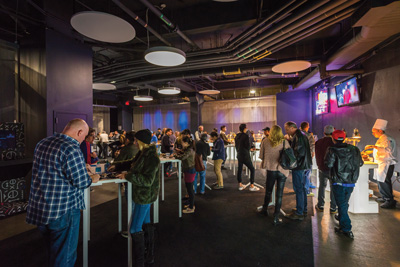 |
The Clippers convert a Zamboni storage area into the Lexus Courtside Club.
Photo by: Shawmut Design and Construction |
their investment. Feedback through mostly pregame conversations indicated the need for a private entrance and a place to enjoy a pregame dinner and relax during halftime, Zucker said.
Unfortunately, the Clippers are third in the arena’s pecking order behind the Kings and Lakers and there was no permanent space to develop a courtside club. To find space, the Clippers and AEG walked the arena and identified a 2,000-square-foot pathway occupied by the Zambonis.
For Clippers games, Staples Center President Lee Zeidman determined, the space could be used to create a premium club that could be set up and torn down within a few hours, keeping in mind the occasional NBA/NHL double-headers where the arena is converted to hockey mode on the same day. To clear space for the club on Clippers game days, the two Zamboni machines are moved to a garage storage area next to the club.
“We spent a lot of time operationally [figuring out] how to do it and still create a venue in an environment that feels permanent when it’s there,” Zucker said.
Meis Architects, whose principal owner Dan Meis originally designed Staples Center, developed the space in tandem with the Clippers. Shawmut Design and Construction built the Lexus club. The investment ran in the high six figures, a cost covered by the Clippers, project officials said.
Food and drink is folded into the season-ticket package, so there is no need for those customers to reach for their wallet to pay for additional services. They have a new private entrance that was previously used only for performers at the annual Grammy Awards at the arena.
As part of the club design, the metal mesh curtaining system used to form the temporary walls was modeled after the same material Zucker saw used as a wall treatment inside a permanent club at Barclays Center during her tour of NBA arenas to get ideas for the Clippers’ club.
The Clippers added soft lighting with colored gels to create texture to the temporary walls, to effectively reduce the “harsh mechanical feel” typical of an arena’s service level, Zucker said.
Levy Restaurants, Staples Center’s concessionaire, created a menu to match the higher standards expected by courtside ticket holders. The menu includes a buffet with chilled seafood, fresh salads and a carving station, in addition to standard fare such as hot dogs and popcorn. The soft-serve ice cream machine has been a big hit and those customers can head to their seats with grab-and-go buckets of trail mix, peanuts and gummy bears.
Lexus, a new Clippers sponsor last season, signed a three-year agreement to brand the club. Xbox and PlayStation 4 consoles were brought in to help keep families with children entertained during game breaks.
Zucker said the club’s first year of operation was followed by a 99 percent renewal rate for courtside seat holders.
“What you hear a lot about is how nice it is to have a space where they can get to know everybody there,” she said.
“They also like the convenience of it, to know that with 20 minutes before tipoff, you’re able to run in there and get something to eat. When you can do something like that, create a new revenue opportunity and also a better experience, everybody’s interested.”
WEST END SEATS
Barclays Center
The New York Islanders began play last season in an arena designed exclusively for basketball. When the arena is converted for hockey, 2,500 seats have limited views. At ice level, though, five rows of 130 temporary seats feature some of the best views of the action at an NHL facility.
Dealing with the wrong geometry for hockey, Barclays Center staff seized the opportunity to create a high-end experience for Islanders fans on the west end, which is the stage end for concerts. For Nets games, a separate retractable seating system is installed at that end of the arena.
Hockey fans occupying those seats are steps away from the Billboard Lounge and the Calvin Klein Club where they have access to complimentary food and nonalcoholic drinks. As a result, those seats are among the most expensive locations in the building. Tickets start at $300 a game for the back rows and go up to $750 a game for the first row next to the glass. Single-game tickets for those seats are dynamically priced.
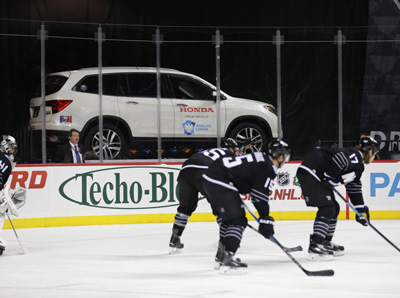 |
At Islanders games, a Honda Pilot's horn blows and its headlights and taillights flash after the team scores.
Photo by: Brooklyn Sports & Entertainment |
The cushioned seats are on the glass right behind the net where the Islanders defend twice. The seats rise three feet off the floor, which is two feet higher than the average front row seats behind the goals at most NHL arenas, providing clear views above the dasherboards, said Barclays Center general manager Steve Rosebrook.
In addition to being close to the action, West End ticket holders sit to the right of where the Islanders enter and exit the ice through the player tunnel. West Enders also get access to exclusive events with the Islanders and team alumni, and receive first rights to buy tickets to other Barclays Center events before the public on-sale.
Rosebrook, a “hockey guy from Canada,” opened Canadian Tire Centre and Air Canada Centre in the 1990s. As an experienced operator of NHL facilities, he worked closely with Barclays Center CEO Brett Yormark to develop those seats and amenities.
“We came up with a great plan that paid dividends throughout the year,” Rosebrook said. “At most rinks, the pitch goes a foot off the floor. Here, when the puck’s coming from the blue line and a guy misses and it hits the glass … you put your hands up [by instinct]. The kids love it.”
Another twist is a new piece of activation tied to Honda’s sponsorship package. The automaker had an existing deal with the arena and the Nets, which includes naming rights to a club. As the Islanders came into play, Honda folded the NHL team into its agreement as part of a three-year extension.
For hockey games, Honda displays a Pilot SUV on a ramp behind the goal in the west end. Every time the puck plays in that zone, the SUV shows up on the broadcast, adding value to Honda’s deal, said Mike Zavodsky, Barclays Center’s executive vice president of global partnerships.
The kicker: For every Islanders goal, the Pilot’s horn blows and its headlights and taillights flash by remote control, serving as a focal point of the in-game experience, Zavodsky said.
All told, the West End seats are a nice upgrade for Islanders fans and they’ve become a great tool for pitching potential season-ticket holders.
“You get an appreciation for how quick the sport really is,” Rosebrook said.
AUDI SUITES
Los Angeles Memorial Coliseum
USC football, playing in a vintage stadium with 93,600 bench seats, has done its best to create a premium experience for the school’s top donors and alumni.
About 20 years ago, the Pac-12 school began setting up hospitality tents among the historic peristyles at the top of the seating bowl on the facility’s east end. Over the past six years, those tents have morphed into the Audi Suites, which are sturdier structures built with movable walls and glass doors.
The 10 temporary suites, equipped with air conditioning, can each accommodate up to 70 people. USC Sports Properties, a division of Fox Sports, the school’s multimedia rights holder, has sold the suites in the past for about $25,000 a game.
Two years ago, the concept expanded to a dozen Audi-branded structures featuring suites and club seats at field
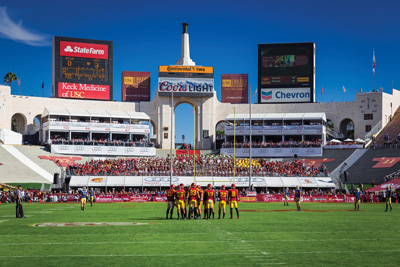 |
USC donors and alumni attending football games can use temporary suites at the top of the seating bowl or at field level.
Photo by: Los Angeles Memorial Coliseum |
level behind the east end zone. Legends, the stadium’s concessionaire, sold those units for $75,000 to $95,000 last season as part of its food service deal with USC.
“What started out as a pop-up tent has led to us doing something better to create more premium space,” said Joe Furin, the coliseum’s general manager.
As it stands now, both sets of temporary suites are installed shortly before the football season starts and are taken down in early January.
This year, the rechristened Los Angeles Rams join USC at the coliseum, which means the Audi Suites will pop up a few weeks earlier in time for the NFL team’s first preseason game, set for Aug. 13 against the Dallas Cowboys.
The Rams will play three seasons at the coliseum before moving into their new $2.5 billion stadium in Inglewood for the 2019 season. At the coliseum, they settled on using the Audi Suites internally for hospitality and for sponsors to entertain guests, and won’t sell them to the public, said Kevin Demoff, the Rams’ executive vice president of football operations and chief operating officer.
“The Rams have been very accommodating,” Furin said. “They’re not asking us for any more than we do outside of a USC game.”
Starting late next year, the premium landscape will go through a transformation at the 93-year-old stadium. After the 2017 season, a two-year, $270 million renovation kicks off at the coliseum. The centerpiece is a new south side tower that will offer suites, club seats and loge boxes. After the upgrades are completed, the peristyle suites will go away, but the field-level suites will remain for USC games, Furin said.
“We’re looking for more creative ways to offer premium opportunities for our clients,” he said. “The industry has changed with a lot of socialization and networking. You don’t necessarily have to see the action. At Coachella [a music festival in Southern California], they were selling $1,000 bungalows with no view of the stage front. That’s the trend, to find something different.”
PADDOCK LOUNGE
Circuit of the Americas
Circuit of the Americas, the Austin, Texas, road racing course, features the paddock in the middle of the facility, an area similar to the garages and pit areas at NASCAR tracks that’s accessible to fans at an upcharge, said Jason Rittenberry, Circuit of the Americas’ chief strategy officer.
For events outside of F1, which does not offer paddock access for its event in Austin due to space restrictions, the $250 passes give racing fans the opportunity to rub elbows with race participants, sponsors and other VIPs, Rittenberry said.
Until this year, though, paddock activities were limited to those purchasing passes in addition to their race ticket. To liven up the space and provide greater value, COTA officials developed the Paddock Lounge for the 2016 MotoGP Red Bull Grand Prix of the Americas, which was held April 8-10.
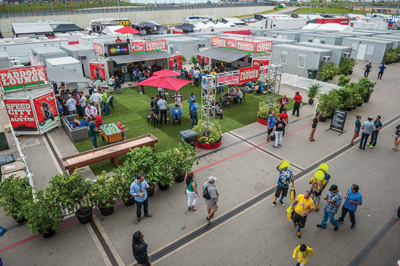 |
Circuit of Americas deploys specially equipped shipping containers to create an outdoor lounge.
Photo by: Circuit of the Americas |
The outdoor lounge centered around three shipping containers equipped with televisions programmed with DirecTV and also featuring ceiling fans, high-top tables and outdoor seating.
The area bordered by the containers extended to a carpeted floor, small couches, foosball and shuffleboard games. A disc jockey spun tunes to provide Paddock Lounge patrons with live entertainment.
The lounge also provided additional points of sale for COTA concessionaire RS3 to sell food and drink. The average spend in that space alone was about $15 for the three-day event, Rittenberry said.
For the motorcycle races, the look was completed with Red Bull-branded seating, tables and bars as part of the energy drink’s event sponsorship. COTA invested $70,000 to build the lounge, which included renting the shipping containers from Block Party Suites, a Dallas company.
“It’s nice and upscale,” Rittenberry said. “We didn’t want just a tent. We found Block Party Suites and liked what we saw. We partnered with Red Bull on the lounge and they assisted in the layout and design.”
Block Party Suites has supplied themed shipping containers for tailgate zones outside of college football stadiums (SportsBusiness Journal, Aug. 17-23, 2015), and it’s now starting to see interest from schools for temporary hospitality inside their facilities, said company CEO Adam Ward.
Over the past three months, Minnesota, Louisiana Tech, Harvard, New Mexico State, Richmond and Louisville have all shown interest in setting up furnished shipping containers in the end zones of their stadiums. To this point, the Golden Gophers are the only college program moving ahead with the idea and is currently going through bids from Block Party Suites and other vendors, Ward said.
In Austin, the success and buzz surrounding the Paddock Lounge led to the track’s decision to bring it back for the Lone Star Le Mans race weekend, set for Sept. 15-17.
“Fans are looking to be entertained more than just for the primary purpose of the event,” Rittenberry said. “We’re going to have to start looking at doing more of this with the demographics changing in the race world. I’ve seen it at NHRA, NASCAR and F1. The expectations are greater.”








